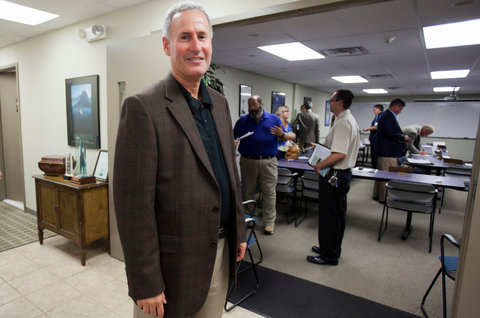At a time when it can seem as if all retailing is migrating online, many consumer staples still live or die based on their placement in the detailed schematics that stores like Duane Reade use to maximize the profitability of their shelf space. For an upstart brand with no track record, securing any spot in these schematics, or plan-o-grams, as they are known, is difficult. To stake a claim to the prized ground near the registers is all but impossible, akin to a struggling young artist moving his milk crates into a Park Avenue co-op.
Or so it seemed until Jordan Eisenberg came along.
Mr. Eisenberg, 31, is the founder of UrgentRx, maker of single-dose foil packets of flavored, powdered over-the-counter medications with the same active ingredients found in products like Bayer, Pepto Bismol, Benadryl and Excedrin. Designed to be taken without water, the UrgentRx versions have been selling well enough that the company expects revenue this year of more than $3 million. Based in Denver, with 10 employees, the company has attracted more than $7 million in financing from investors like Sam Zell and Herb Simon, real estate moguls; David Bonderman, a private equity billionaire; and Hilary Swank, the actress.
But what really seems to have propelled the company’s early success are the inroads Mr. Eisenberg has made with major retailers. In the three years since the company’s debut, he has placed UrgentRx products near the checkout counter at 2,700 retail outlets across the country, including those of Duane Reade, Walmart and Kroger. Recent agreements and continuing negotiations, he estimates, should put the products in 27,000 stores by the end of the year. Merchandising fees — when big chains do take a flier on a new brand, they often charge stiff first-time stocking fees — have been less than $100,000, he said.
How has he done it? With a simple insight: Mr. Eisenberg realized that while most small brands cannot break into the plan-o-gram, they can persuade retailers to give them access to the unused space in the margins beyond the plan-o-gram. This insight has earned Mr. Eisenberg a reputation as a kind of “store seer,” a master at finding wasted spaces hidden in plain sight. Employing a variety of custom-fabricated display units, the burly former engineering major has designed lazy susan-like trays that spin atop the stanchions of queue lines, racks that hang off the ends of display walls, and oddly shaped shelving units that seem to levitate above sale counters.
“What he’s doing is one step beyond audacious,” said Kim Feil, chief marketing officer for OfficeMax, which recently signed an agreement to allow a horizontal UrgentRx display to sit atop the candy, mint and gum rack at the front of its checkout lanes. A 30-year merchandising veteran, Ms. Feil likened Mr. Eisenberg’s tactics to when 5-Hour Energy got its individual shot-size bottles into the racks by developing a carton of 12 with a tear-off lid and the precise dimensions of a candy, mint or gum slot. “But there haven’t been too many others,” she said.
On a recent afternoon, Mr. Eisenberg was visiting Manhattan, testing his latest prototype for Duane Reade. Although the chain has already installed his lazy susan queue-line display in two-thirds of its locations, its older and smaller stores do not have queue lines. So Mr. Eisenberg asked his fabricator to fashion a different sort of display — a 2-by-12-inch, white powder-coated strip of metal with three clear acrylic pockets affixed to the front.
Near 44th Street and Ninth Avenue, Mr. Eisenberg entered an older Duane Reade, clutching his prototype filled with packets of UrgentRx, to scope out spots near the front of the store. At the register, a cashier surrounded by razors, cigarettes, nicotine replacements, candy and gum was ringing up a customer. Next to the register, a stack of chocolates took up what little counter space was available. Then the UrgentRx rack popped into view, Mr. Eisenberg holding it up to show how it could be fastened to the back of the arm supporting the register screen. Suddenly, it was the most prominent point of sale in the store.
A moment later, he was standing by a metal refrigerated case in a prime location across from the counter. He held the same rack flush against the side of the case. “Put some magnets on the back and it could also go right there,” he said. On the other side of the case, where a clear acrylic rack of Lifesavers mints was attached, he showed how his rack could go on the side of the Lifesavers rack. “This is why my wife won’t go into stores with me anymore,” he said.
He is clearly something of an obsessive. After reading “Secrets from an Inventor’s Notebook” in college, he talked his way into an apprenticeship with its author, Maurice Kanbar, the originator of both Skyy vodka and a type of lint remover, calling on Mr. Kanbar’s office at least once a month for two years before landing a meeting. He eventually assisted Mr. Kanbar with the start of four companies.
By the time Mr. Eisenberg was 27, he had founded two companies on his own: CollarCard, maker of a credit-card-size shirt stay holder given out as a premium by men’s wear chains; and PMS Buddy, an app that reminded men when their wives or girlfriends were having their periods. The app received 30,000 downloads the day Ashton Kutcher, the actor and Twitter sensation, tweeted about it.
The inspiration for UrgentRx came to Mr. Eisenberg, who is severely allergic to raw fruits and vegetables, while disinterring a Benadryl pill that he used to wrap in cellophane and carry in his wallet in case his throat swelled up. The idea solidified when he realized that his father, then 61, was doing the same thing with aspirin, which is known to improve one’s chances of surviving a heart attack. Soon after test-marketing began in Colorado, Mr. Eisenberg became the subject of local news reports when a Denver man claimed that the UrgentRx’s aspirin formulation had saved his life.
Mr. Eisenberg says he believes that many brands can learn from his unorthodox merchandising methods. Walking into a Staples outlet on Broadway, he said that a lot of brands made the mistake of skimping when designing display equipment. He pointed to the counter where a dented plastic container was nearly drained of hand sanitizer bottles. “See, as soon as those are gone,” he said, “that’s going to get thrown out because it looks cheap.”
In the next block, Mr. Eisenberg came across another Duane Reade, this one in a newer location. Inside, he noticed that half of the UrgentRx packets in a display were either upside down or in the wrong slots. “It’s a constant battle,” he said, pulling out all of the packets, re-sorting them and then placing them in the appropriate slots. He noticed a woman waiting in line with a box of Benadryl.
“Here, you should try this instead,” said Mr. Eisenberg, handing her a packet of UrgentRx Allergy Relief To-Go. “It’s much better than that other product.”
She took the packet, read the back of the package, and returned the Benadryl, before turning to the cashier: “I’ll try one of these.”
“I have no shame,” Mr. Eisenberg said.

Article source: http://www.nytimes.com/2013/08/08/business/smallbusiness/how-urgentrx-crashed-the-party-at-the-cash-register.html?partner=rss&emc=rss




